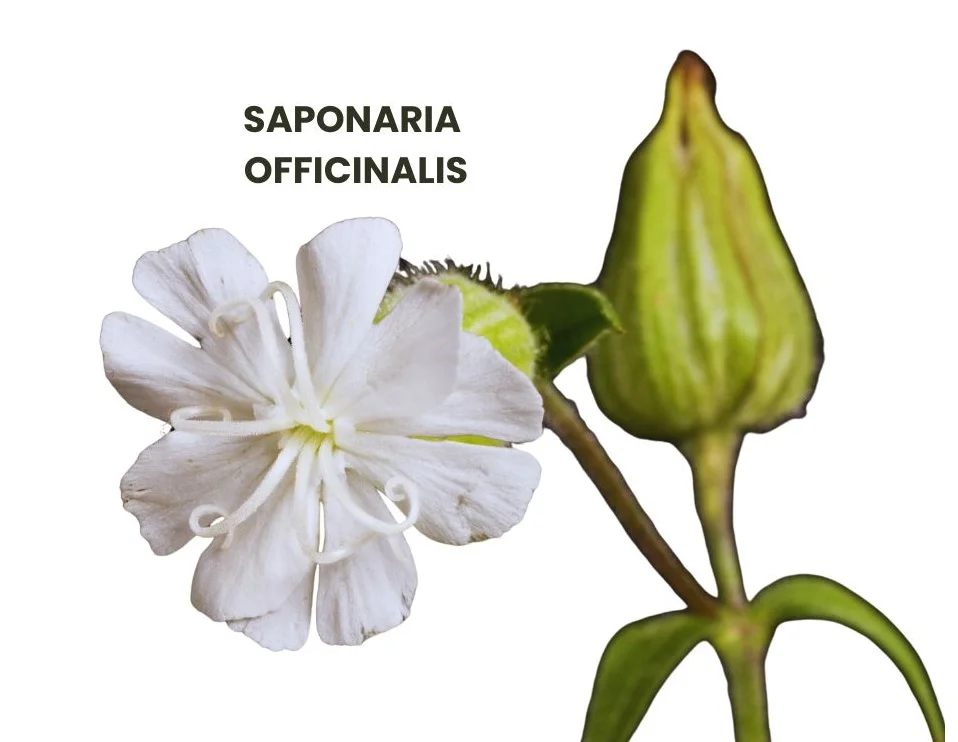Saponaria officinalis, commonly known as Soap Root, is a valuable homeopathic remedy, particularly useful in treating acute colds, coryza (nasal inflammation), and sore throats.
It is known for its ability to “break up” a cold effectively.
Saponaria officinalis, or Soap Root, has been used for centuries for its medicinal properties.
The plant contains saponins, which have soap-like qualities and are believed to help cleanse and purify the body.
This remedy is particularly noted for its effectiveness in treating respiratory ailments and certain neuralgic conditions.

Table of Contents
ToggleSOURCE INFORMATION
Scientific Classification
- Kingdom: Plantae
- Order: Caryophyllales
- Family: Caryophyllaceae
- Genus: Saponaria
- Species: Saponaria officinalis
Origin
- Soap Root is native to Europe and Asia but has been naturalized in many parts of North America.
- The plant thrives in well-drained soil and is often found in meadows, roadsides, and riverbanks.
Historical Facts
- Historically, Soap Root has been used as a soap substitute due to its high saponin content.
- It has also been employed in traditional medicine to treat a variety of ailments, including respiratory infections, skin conditions, and digestive issues.
DRUG PATHOGENESIS
- Saponaria officinalis primarily affects the respiratory, digestive, and nervous systems.
- Its active compounds, saponins, contribute to its expectorant, anti-inflammatory, and antimicrobial properties.
- These actions make it effective in treating colds, coryza, sore throats, and certain types of neuralgia.
KEY CHARACTERISTICS
- Effective in treating acute colds and coryza.
- Relieves sore throats and respiratory congestion.
- Addresses neuralgic pains, particularly in the trigeminal nerve.
- Induces a sense of indifference to pain and possible death, accompanied by apathy and depression.
- Alleviates symptoms such as headache, eye pain, and digestive discomfort.
DETAILED ORGAN SYMPTOMS
MIND
- Indifference to Pain or Death: Individuals may exhibit a lack of concern or response to pain or the potential for death, showing a profound sense of apathy.
- Apathetic and Depressed Mood: A noticeable lack of interest in activities, often accompanied by feelings of sadness and an overwhelming desire to sleep.
HEAD
- Stitching Pain in Supraorbital Region: Sharp, stabbing pains above the eyes, particularly worse on the left side, in the evening, and with motion.
- Throbbing Pain Over Orbits: Pulsating headaches concentrated around the eye sockets.
- Head Congestion: A sensation of fullness and pressure in the head, accompanied by fatigue in the neck area.
- Coryza with Drunken Sensation: Nasal inflammation that makes the person feel as if they are drunk, with a tendency to move towards the left side.
- Left-Sided Trigeminal Neuralgia: Severe, stabbing pain in the trigeminal nerve, especially around the left eye.
- Nasal Congestion, Itching, and Sneezing: A persistent feeling of a blocked nose, along with frequent itching and sneezing.
EYES
- Violent Eye Pains: Intense, sharp pains within the eyeball.
- Ciliary Neuralgia: Severe pain affecting the ciliary nerves of the eye, worse on the left side.
- Photophobia: Increased sensitivity to light, causing discomfort or pain.
- Exophthalmos: Eyes may appear to bulge out, with symptoms worsening during activities like reading and writing.
- Increased Intraocular Pressure: Elevated pressure inside the eye, leading to symptoms associated with glaucoma.
STOMACH
- Difficulty Swallowing: Experiencing problems with the act of swallowing food or liquids.
- Nausea and Heartburn: Feeling sick to the stomach, often accompanied by a burning sensation in the chest or throat.
- Full Feeling Unrelieved by Burping: A persistent sensation of fullness in the stomach that is not alleviated by burping.
HEART
- Weak Heart Impulse: A reduced force in the heartbeat, leading to a less frequent pulse.
- Palpitations and Anxiety: The sensation of the heart beating irregularly or forcefully, often accompanied by feelings of anxiety.
MODALITIES
- Symptoms are worse at night.
- Symptoms are aggravated by mental exertion.
- Left-sided symptoms are more pronounced.
WHAT ARE MODALITIES IN HOMOEOPATHY?
RELATIONSHIP WITH OTHER DRUGS
- Compare with: Saponin, a glucosidal principle found in Quillaya, Yucca, Senega, Dioscorea, and other plants (noted for causing tiredness, indifference, left-sided pain, photophobia, neuralgia, migraine, and sore throats).
- Related remedies: Verbascum, Cocculus (both containing Saponin), Quillaya, Anagallis, Agrostemma, Helonias, Sarsaparilla, Paris, and Cyclamen.
DOSE
- The recommended dosage for Saponaria officinalis is typically in homeopathic potencies, such as 6X, 12X, or 30X, depending on the specific condition and the severity of symptoms.
- Consult a qualified homeopath for personalized dosage recommendations.
Frequently Asked Questions (FAQs)
What conditions can Saponaria officinalis treat?
- Saponaria officinalis is effective in treating acute colds, coryza, sore throats, trigeminal neuralgia, and certain eye conditions like ciliary neuralgia and glaucoma.
How does Saponaria officinalis work in treating colds?
- Saponaria officinalis works by reducing inflammation, promoting expectoration, and alleviating congestion in the respiratory tract.
Can Saponaria officinalis be used for digestive issues?
- Yes, Saponaria officinalis can help relieve nausea, heartburn, and a full feeling in the stomach that is not relieved by burping.
Is Saponaria officinalis safe for everyone?
- While generally safe in homeopathic doses, it is best to consult a healthcare professional before using Saponaria officinalis, especially for those with underlying health conditions or those taking other medications.
Glossary of Difficult Words
- Coryza: Inflammation of the mucous membranes in the nose.
- Neuralgia: Intense, typically intermittent pain along the course of a nerve.
- Exophthalmos: Abnormal protrusion of the eyeball.
- Eructation: Burping.
- Photophobia: Sensitivity to light.
- Glaucoma: A group of eye conditions that damage the optic nerve, often due to high intraocular pressure.
